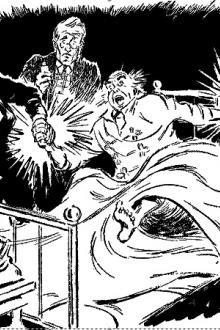The History of a Mouthful of Bread, Jean Macé [best autobiographies to read TXT] 📗

- Author: Jean Macé
Book online «The History of a Mouthful of Bread, Jean Macé [best autobiographies to read TXT] 📗». Author Jean Macé
mermaids and sirens which have been told from the days of Homer downwards, and the traditions of which have not yet quite died out in seaport towns. To have been passed from man to the whale, touching the elephant on the road, is a long way to travel, especially when, after all, one is only a huge barrel of amphibious fat; and you may judge from this that it is not always an easy thing to classify animals.
ORDER 12. Cetacea (whale-kind) .
Cetaceans are whales; and if I had been consulted on the matter, I should have joined this order and the last together, under whatever name was thought most appropriate. The passage from the seal to the whale through the walrus and the sea-cow is an easy and natural one, the two latter being obviously the connecting links; and in spite of certain diversities of food, they form in reality one family-party, as do the marsupials.
But it is too late in the day to talk of this, my dear child, and you and I cannot pretend to alter what is taught in the schools.
But you are astonished, are you not? to hear that the whale is not a fish: and no wonder. It is with it, however, as with the armadillo; it is a fish with a higher organisation inside. The interior of this enormous mass is a faithful reproduction, as a whole, of that of the shrew-mouse; and when we come to talk of fishes you will have some faint idea of the prodigious distance which this places between the whale and his countrymen of the ocean.
As far as we are concerned, the chief difference is in their way of breathing. The cetaceans breathe like ourselves, and are obliged to come to the surface of the water to take air; while fishes have a special apparatus, which I will explain to you presently, which enables them to breathe in the water. This is a disadvantage to the cetacean in his fish life; nevertheless, of all the mammals (as may easily be imagined) he is the one who can remain longest under the water. With us, for instance, the best divers one ever heard of, those who go to the bottom of the sea after the pearl-oyster, can scarcely stay below longer than two minutes; and even during that short time the veins of the head become so overcharged with the blood, which cannot return to the lungs owing to its forced inactivity, that when the diver comes back to the surface it is by no means unusual to see him streaming with blood from both nose and ears. The cetaceans remain under water for half an hour at a time without seeming to suffer in the least; and Breschet, a clever French naturalist, has given a very satisfactory explanation of this wonderful faculty. In dissecting a cetacean, he discovered all along the vertebral column an extensive network of large veins, which are not found in other mammals, and which seemed designed to serve as a refuge place for the blood during the time the animal remains submerged. According to him, this network would act as a reservoir, to which any overplus in the head or important organs would flow through vessels communicating therewith, and which might swell out as it pleased, without any risk to the inert bed of fat against which it lies. From thence the blood rushes to the lungs, as soon as the animal's return to the air enables them to play as usual. It must be admitted, at the same time, that all this involves the necessity of a much less active life than that of land mammals, that is to say, a consumption of oxygen much smaller in proportion than theirs; for were you to be furnished down your back with the finest network reservoir in the world for venous blood, it would still not enable you to remain half an hour without breathing.
There is nothing remarkable in the digestive apparatus of the cetaceans except about the mouth, which is, as you know, the essentially variable point among animals. To begin with, the cetacean tongue has the most original appearance possible. Indeed, it is not a tongue, but a large carpet, spread over the floor of the animal's mouth, and bears not the faintest trace of resemblance to that nimble delicate porter, who does you such good service. Imagine a thick soft lump absolutely crammed with fat, and completely immovable, because it is glued down along its whole length to the bottom of the mouth, and you will have a good idea of this strange tongue, which in the whale, the largest of the cetaceans, attains to the length of twenty-five feet and the width of twelve, and of itself alone furnishes the whale-fishers with from five to six tons of oil. This is a great deal farther from us than even the long string which serves as a tongue to the ant-eater; and you feel at once that we are getting among strangers.
With respect to teeth, I have now a melancholy piece of news to tell you. We have done with them; we have seen the last of incisors, canines, and molars, henceforth you will hear no more about those valuable instruments. The teeth of the cetaceans, with whom this painful falling-off begins, are no more teeth than his tongue is a tongue. They are like so many nails set in a row in the jaw, and can only be of use in retaining prey, not in grinding it; so that of the many processes your bit of bread has to go through before it becomes a part of yourself, there is one which is dispensed with here altogether, namely, mastication. Cetaceans swallow their food without chewing it.
Besides, they have not got a whole set even of these unmasticating teeth. Dolphins and porpoises, those faithful companions of the sailor, around whose vessel they come playing and tumbling in the seas of all countries, are the only ones who have them in both jaws. And these are the small fry of the order; they do not usually exceed six or ten feet in length.
The Cachalot, or Spermaceti Whale, an enormous cetacean, which rivals the true whale in size, and whose head alone forms nearly the half of its body, has teeth in the lower jaw only. This lower jaw, whose two sides are joined together for half their length (a new deviation, very unlike anything we have found before), is so little proportioned to the gigantic head which contains it, that it is almost lost to sight, and seems like a small plank slipped under a great square block.
Such as it is, however, it possesses many very respectable teeth, of which some weigh as much as two pounds; and with these the cachalot, whose ferocity is tremendous, tears in pieces everything that comes near it, sometimes even the boats of the fishermen who risk their lives in the dangerous pursuit of capturing them. By a singular arrangement, of which this is the only known instance, there is, opposite each of the cachalot's teeth, a corresponding cavity in the upper jaw, into which they fit closely, turning the monster's muzzle into the most formidable pair of pincers to be found in the animal kingdom. Another curiosity in the order is the tooth of the Narwhal, a modest cetacean, who is not much more than twenty feet long!
I speak of the tooth , because the creature has commonly but one; a cylindrical-pointed tooth, spirally furrowed, whose length varies from six to ten feet, and which comes straight out from the extreme front of the upper jaw, like a soldier's pike. There are two sockets at this extremity of the jaw, each furnished with a tooth-germ; but as a general rule the germ on the left side is the only one which develops, the other lying asleep in its socket, where it is choked up and never appears. Behind this long pike, which, like the tusk of the elephant, attracts to itself all the ivory in the body, lies a completely unfurnished mouth; so that the owner of this magnificent weapon, invaluable as a war-tool, but quite inapplicable to the purpose of supporting life, is obliged to feed on small fishes and
mollusks . We have not yet spoken about these latter, but if you have ever seen slugs and snails you will know what a mollusk is.
The same wretched food falls to the lot of the whale also, that giant of the ocean, whose open mouth forms an aperture twenty feet in extent. Geoffroy St. Hilaire, in his indefatigable endeavors to trace out points of resemblance connecting together animals the most unlike in outward appearance, discovered, along the lower jaw of a young whale, certain traces of teeth, indicating a last effort on the part of nature to carry out her usual plan in furnishing the jaws of mammals; but, like the right-hand tooth of the narwhal, these vain attempts soon disappear, overgrown and lost in the tissue of the bone, so that the whale offers us a true type of an edentate , classable with the ant-eater, if one dared, and some people have dared, which by this time will not surprise you. A classifying professor is utterly merciless, whether he gets hold of the poor beasts by the mouth or by the paw: they may protest with all the rest of their body against the peg on which they are hung; so much the worse for them! If one were to listen to what they have all got to say, it would be impossible to classify even one.
To return to the whale. As a compensation for the teeth which she found herself unable to give him, nature has manufactured on the two sides of his upper jaw the most extraordinary apparatus without exception to be found in the mammal mouth. You know what is called the
whalebone used in stay-making, &c. The name is quite correct; for those little flexible black strips, which support the figure so nicely, began life in wandering over the polar or Australasian seas, fastened to the palate of some monstrous whale.
On the two sides of the upper jaw the membrane which covers the palate sends out rows of broad, thin, horny plates, which are from eight to ten feet long (they have sometimes been seen twenty-five feet) in the centre of each side, but which decrease gradually towards the extremities. These are plates of whalebone (sometimes called whale's whiskers), and the industry of man has turned them to a thousand different uses; and you will open your eyes in astonishment when I tell you that 800 or 900 of them have been sometimes counted on each side of one mouth. Think of the number of stays that could be furnished from the whalebone plates of one whale! It is true, they were not exactly designed for this purpose originally. At the tips and on the edges of these plates, the elastic fibres of which they are composed unravel and peel off, and hang down from the lip like tufts of horsehair. The Arctic seas, which the whale inhabits, are, like other seas, full of innumerable troops of various little sea-animals, and it is these which are destined to the honor of nourishing this gigantic mass of flesh. When the colossus wishes to take a meal, he stretches his mouth to its utmost width, and the salt water rushing in as into a gulf, carries with it the imprudent little fry, who disappear then and there for ever, being retained by the fringe-like sieve of the whalebone. But as, in this way of eating, the stomach of the whale, however large, would be terribly
ORDER 12. Cetacea (whale-kind) .
Cetaceans are whales; and if I had been consulted on the matter, I should have joined this order and the last together, under whatever name was thought most appropriate. The passage from the seal to the whale through the walrus and the sea-cow is an easy and natural one, the two latter being obviously the connecting links; and in spite of certain diversities of food, they form in reality one family-party, as do the marsupials.
But it is too late in the day to talk of this, my dear child, and you and I cannot pretend to alter what is taught in the schools.
But you are astonished, are you not? to hear that the whale is not a fish: and no wonder. It is with it, however, as with the armadillo; it is a fish with a higher organisation inside. The interior of this enormous mass is a faithful reproduction, as a whole, of that of the shrew-mouse; and when we come to talk of fishes you will have some faint idea of the prodigious distance which this places between the whale and his countrymen of the ocean.
As far as we are concerned, the chief difference is in their way of breathing. The cetaceans breathe like ourselves, and are obliged to come to the surface of the water to take air; while fishes have a special apparatus, which I will explain to you presently, which enables them to breathe in the water. This is a disadvantage to the cetacean in his fish life; nevertheless, of all the mammals (as may easily be imagined) he is the one who can remain longest under the water. With us, for instance, the best divers one ever heard of, those who go to the bottom of the sea after the pearl-oyster, can scarcely stay below longer than two minutes; and even during that short time the veins of the head become so overcharged with the blood, which cannot return to the lungs owing to its forced inactivity, that when the diver comes back to the surface it is by no means unusual to see him streaming with blood from both nose and ears. The cetaceans remain under water for half an hour at a time without seeming to suffer in the least; and Breschet, a clever French naturalist, has given a very satisfactory explanation of this wonderful faculty. In dissecting a cetacean, he discovered all along the vertebral column an extensive network of large veins, which are not found in other mammals, and which seemed designed to serve as a refuge place for the blood during the time the animal remains submerged. According to him, this network would act as a reservoir, to which any overplus in the head or important organs would flow through vessels communicating therewith, and which might swell out as it pleased, without any risk to the inert bed of fat against which it lies. From thence the blood rushes to the lungs, as soon as the animal's return to the air enables them to play as usual. It must be admitted, at the same time, that all this involves the necessity of a much less active life than that of land mammals, that is to say, a consumption of oxygen much smaller in proportion than theirs; for were you to be furnished down your back with the finest network reservoir in the world for venous blood, it would still not enable you to remain half an hour without breathing.
There is nothing remarkable in the digestive apparatus of the cetaceans except about the mouth, which is, as you know, the essentially variable point among animals. To begin with, the cetacean tongue has the most original appearance possible. Indeed, it is not a tongue, but a large carpet, spread over the floor of the animal's mouth, and bears not the faintest trace of resemblance to that nimble delicate porter, who does you such good service. Imagine a thick soft lump absolutely crammed with fat, and completely immovable, because it is glued down along its whole length to the bottom of the mouth, and you will have a good idea of this strange tongue, which in the whale, the largest of the cetaceans, attains to the length of twenty-five feet and the width of twelve, and of itself alone furnishes the whale-fishers with from five to six tons of oil. This is a great deal farther from us than even the long string which serves as a tongue to the ant-eater; and you feel at once that we are getting among strangers.
With respect to teeth, I have now a melancholy piece of news to tell you. We have done with them; we have seen the last of incisors, canines, and molars, henceforth you will hear no more about those valuable instruments. The teeth of the cetaceans, with whom this painful falling-off begins, are no more teeth than his tongue is a tongue. They are like so many nails set in a row in the jaw, and can only be of use in retaining prey, not in grinding it; so that of the many processes your bit of bread has to go through before it becomes a part of yourself, there is one which is dispensed with here altogether, namely, mastication. Cetaceans swallow their food without chewing it.
Besides, they have not got a whole set even of these unmasticating teeth. Dolphins and porpoises, those faithful companions of the sailor, around whose vessel they come playing and tumbling in the seas of all countries, are the only ones who have them in both jaws. And these are the small fry of the order; they do not usually exceed six or ten feet in length.
The Cachalot, or Spermaceti Whale, an enormous cetacean, which rivals the true whale in size, and whose head alone forms nearly the half of its body, has teeth in the lower jaw only. This lower jaw, whose two sides are joined together for half their length (a new deviation, very unlike anything we have found before), is so little proportioned to the gigantic head which contains it, that it is almost lost to sight, and seems like a small plank slipped under a great square block.
Such as it is, however, it possesses many very respectable teeth, of which some weigh as much as two pounds; and with these the cachalot, whose ferocity is tremendous, tears in pieces everything that comes near it, sometimes even the boats of the fishermen who risk their lives in the dangerous pursuit of capturing them. By a singular arrangement, of which this is the only known instance, there is, opposite each of the cachalot's teeth, a corresponding cavity in the upper jaw, into which they fit closely, turning the monster's muzzle into the most formidable pair of pincers to be found in the animal kingdom. Another curiosity in the order is the tooth of the Narwhal, a modest cetacean, who is not much more than twenty feet long!
I speak of the tooth , because the creature has commonly but one; a cylindrical-pointed tooth, spirally furrowed, whose length varies from six to ten feet, and which comes straight out from the extreme front of the upper jaw, like a soldier's pike. There are two sockets at this extremity of the jaw, each furnished with a tooth-germ; but as a general rule the germ on the left side is the only one which develops, the other lying asleep in its socket, where it is choked up and never appears. Behind this long pike, which, like the tusk of the elephant, attracts to itself all the ivory in the body, lies a completely unfurnished mouth; so that the owner of this magnificent weapon, invaluable as a war-tool, but quite inapplicable to the purpose of supporting life, is obliged to feed on small fishes and
mollusks . We have not yet spoken about these latter, but if you have ever seen slugs and snails you will know what a mollusk is.
The same wretched food falls to the lot of the whale also, that giant of the ocean, whose open mouth forms an aperture twenty feet in extent. Geoffroy St. Hilaire, in his indefatigable endeavors to trace out points of resemblance connecting together animals the most unlike in outward appearance, discovered, along the lower jaw of a young whale, certain traces of teeth, indicating a last effort on the part of nature to carry out her usual plan in furnishing the jaws of mammals; but, like the right-hand tooth of the narwhal, these vain attempts soon disappear, overgrown and lost in the tissue of the bone, so that the whale offers us a true type of an edentate , classable with the ant-eater, if one dared, and some people have dared, which by this time will not surprise you. A classifying professor is utterly merciless, whether he gets hold of the poor beasts by the mouth or by the paw: they may protest with all the rest of their body against the peg on which they are hung; so much the worse for them! If one were to listen to what they have all got to say, it would be impossible to classify even one.
To return to the whale. As a compensation for the teeth which she found herself unable to give him, nature has manufactured on the two sides of his upper jaw the most extraordinary apparatus without exception to be found in the mammal mouth. You know what is called the
whalebone used in stay-making, &c. The name is quite correct; for those little flexible black strips, which support the figure so nicely, began life in wandering over the polar or Australasian seas, fastened to the palate of some monstrous whale.
On the two sides of the upper jaw the membrane which covers the palate sends out rows of broad, thin, horny plates, which are from eight to ten feet long (they have sometimes been seen twenty-five feet) in the centre of each side, but which decrease gradually towards the extremities. These are plates of whalebone (sometimes called whale's whiskers), and the industry of man has turned them to a thousand different uses; and you will open your eyes in astonishment when I tell you that 800 or 900 of them have been sometimes counted on each side of one mouth. Think of the number of stays that could be furnished from the whalebone plates of one whale! It is true, they were not exactly designed for this purpose originally. At the tips and on the edges of these plates, the elastic fibres of which they are composed unravel and peel off, and hang down from the lip like tufts of horsehair. The Arctic seas, which the whale inhabits, are, like other seas, full of innumerable troops of various little sea-animals, and it is these which are destined to the honor of nourishing this gigantic mass of flesh. When the colossus wishes to take a meal, he stretches his mouth to its utmost width, and the salt water rushing in as into a gulf, carries with it the imprudent little fry, who disappear then and there for ever, being retained by the fringe-like sieve of the whalebone. But as, in this way of eating, the stomach of the whale, however large, would be terribly
Free e-book «The History of a Mouthful of Bread, Jean Macé [best autobiographies to read TXT] 📗» - read online now
Similar e-books:





Comments (0)